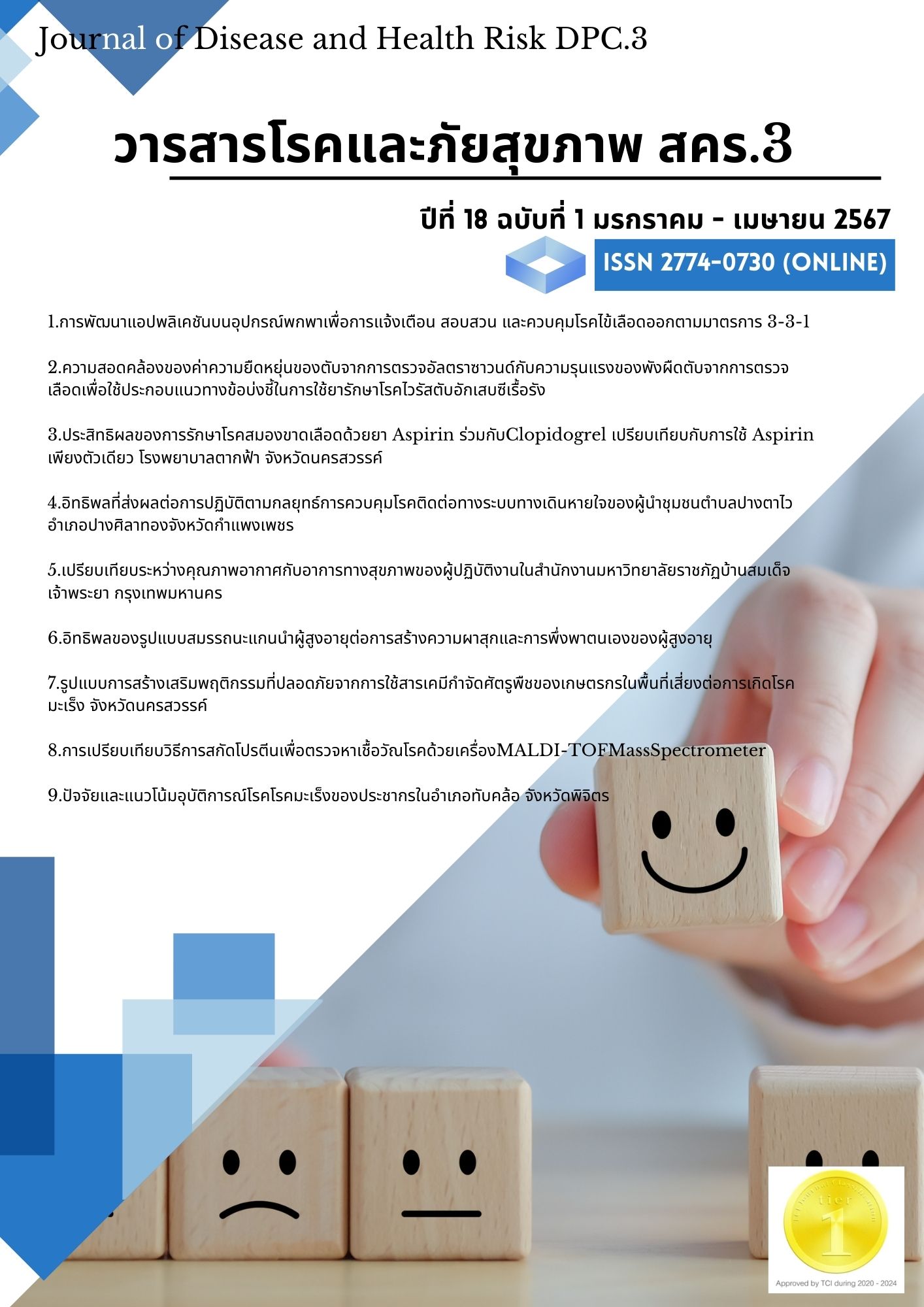Comparison between Air Quality and the Health Symptoms among Computer Office Workers of Bansomdejchaopraya Rajabhat University, Bangkok
Keywords:
Indoor air quality, Health symptoms, Computer officesAbstract
This cross-sectional study was to compare indoor air quality (IAQ) and the health symptoms among computer office workers at the Bansomdejchaopraya Rajabhat University in Bangkok. Seventy-two workers were included in this study. A multi-stage random sampling method was used to divide the proportion of each faculty. Data were collected data using the questionnaire which consisted of the feel of the IAQ in the office and the health symptoms in the past month. Carbon dioxide (CO2), temperature (T), relative humidity (RH), air movement (AM), and total volatile organic compounds (VOCs) were measured using a multi- RAE plus and velocicalc air velocity meter. The Descriptive statistics and Mann-Whitney U test were used to analyze data. The results of the study revealed that the majority of workers (77.8%) sat and worked in the office, with most of them having a working period of fewer than 10 years. In the past month, the most common health issue among workers was back pain, affecting 54.2% of them. This was followed by eye irritation (47.2%), sneezing (52.8%), and headaches (51.4%). In terms of comparisons, it was found that workers experiencing eye irritation, nasal congestion, and headaches worked in areas with statistically significantly higher carbon dioxide concentrations compared to those without health symptoms (p = 0.002, 0.024, and 0.041, respectively). Additionally, workers with burning eyes worked in areas with statistically significantly higher wind speeds than those without symptoms (p = 0.024). In summary, the levels of carbon dioxide emissions and wind speed have an impact on the health effects of office computer users. Therefore, it is recommended to inspect the operation of air ventilation or consider additional installations, maintain the wind speed at a comfortable and acceptable range of 0.10-0.30 meters per second, and arrange workstations so that the direction of airflow does not directly affect the eyes of the workers.
References
Baecher C, Sohui F, Ball L, Masson O. Indoor air quality: a multifaceted public health problem. Field Actions Science Reports [Internet]. 2020 [cited 2022 Oct 7]. Available from: https://journals.openedition.org/factsreports/5986
Tran VV, Park D, Lee YC. Indoor air pollution, related human diseases, and recent trends in the control and improvement of indoor air quality. Int J Environ Res Public Health 2020; 17(8): 2927.
Jafari MJ, Khajevandi AA, Mousavi NSA, Yekaninejad MS, Pourhoseingholi MA, Omidi L, et al. Association of sick building syndrome with indoor air parameters. Tanaffos 2015; 14(1): 55-62.
Tietjen GE, Khubchandani J, Ghosh S, Bhattacharjee S, Kleinfelder J. Headache symptoms and indoor environmental parameters: Results from the EPA BASE study. Ann Indian Acad Neurol 2012; 15: S95-9.
United States Environmental Protection Agency (USEPA). Indoor Air Facts No. 4 (Revised) Sick Building Syndrome [Internet]. 2014 [cited 2022Jun13]. Available from: https://www.epa.gov/sites/default/files/2014-08/documents/sick_building_factsheet.pdf
Dhungana P, Chalise M. Prevalence of sick building syndrome symptoms and its associated factors among bank employees in Pokhara Metropolitan, Nepal. Indoor Air 2020; 30: 244–50.
World Health Organization (WHO). Household air pollution and health. [Internet]. 2020 [cited 2020Jan28]. Available from: https://www.who.int/en/news-room/factsheets/detail/household-air-pollution-and-health.
Surawattanasakul V, Sirikul W, Sapbamrer R, Wangsan K, Panumasvivat J, Assavanopakun P, et al. Respiratory symptoms and skin sick building syndrome among office workers at University Hospital, Chiang Mai, Thailand: associations with indoor air quality, AIRMED Project. Int J Environ Res Public Health 2022; 19(17): 10850.
Sakellaris I, Saraga D, Mandin C, Kluizenaar Y, Fossati S, Spinazzè A, et al. Association of subjective health symptoms with indoor air quality in European office buildings: The OFFICAIR project. Indoor air 2021; 31(2): 426-39.
Polyong CP, Hinkarn T, Saenbie J, Sangkhaw K. Promphinit P. Chitpirom K, et al. Thermal discomfort in classrooms at different times of the day in a university in Bangkok. Disease Control Journal 2020; 46(3): 291-302. (in Thai)
Azuma K, Ikeda K, Kagi N, Yanagi U, Osawa H. Prevalence and risk factors associated with nonspecific building-related symptoms in office employees in Japan: relationships between work environment, Indoor Air Quality, and occupational stress. Indoor Air 2015; 25(5): 499-511.
Abdel-Hamid MA, Hakim S, Elokda EE, Mostafa NS. Prevalence and risk factors of sick building syndrome among office workers. J Egypt Public Health Assoc 2013; 88(2): 109-14.
Han CC, Liu R, Liu RR, Zhu ZH, Yu RB, Ma L. Prevalence of asthenopia and its risk factors in Chinese college students. Int J Ophthalmol 2013; 6(5): 718-22.
Jafari MJ, Khajevandi AA, Karamali F, Zabeti F. Indoor carbon dioxide concentrations and sick building syndrome symptoms in office workers of petroleum industry health organization. International Archives of Health Sciences 2018; 5(3): 82.
Department of Health. Operational manual for assessing indoor air quality for officials. Bureau of Environmental Health, Ministry of Public Health. Nonthaburi: 2016. (in Thai)
Yamtraipat N, Khedari J, Hirunlabh J, Thermal comfort standards for air-conditioned buildings in hot and humid Thailand considering additional factors of acclimatization and education Level. Solar Energy 2005; 78: 504-17.
Krungkraipetch K, Krungkraipetch L. The prevalence of sick building syndrome of official workers in Burapha University, Bangsaen collage. Chonburi: Burapha University; 2011. (in Thai)
Saisakares S, Yimprayoon C. Indoor air quality improvement in office: A case study of interior renovation for office use. Journal of Buildings Energy and Environment 2021; 4(1): 75-91. (in Thai)
Kapalo P, Vilčeková S, Mečiarová Ľ, Domnita F, Adamski M. Influence of indoor climate on employees in office buildings - a case study. Sustainability 2020; 12(14): 5569.
Meggs WJ. Neurogenic switching: a hypothesis for a mechanism for shifting the site of inflammation in allergy and chemical sensitivity. Environ Health Perspect 1995; 103: 54–6.
Tattiyakul V. Computer vision syndrome. Eye South East Asia 2007; 2(1): 40-4. (in Thai)
Ranasinghe P, Wathurapatha WS, Perera YS, Lamabadusuriya DA, Kulatunga S, Jayawardana N, et al. Computer vision syndrome among computer office workers in a developing country: an evaluation of prevalence and risk factors. BMC Res Notes 2016; 9: 150.
Kamøy B, Magno M, Nøland ST, Moe MC, Petrovski G, Vehof J, et al. Video display terminal use and dry eye: preventive measures and future perspectives. Acta Ophthalmologica 2022, 100(7): 723-39.
Downloads
Published
How to Cite
Issue
Section
License
Copyright (c) 2024 Journal of Disease and Health Risk DPC.3

This work is licensed under a Creative Commons Attribution-NonCommercial-NoDerivatives 4.0 International License.
Copyright notice
Article published in the Journal of Disease and Health Risk DPC.3 Nakhon Sawan. It is considered a work of academic research and analysis as well as the personal opinion of the author. It is not the opinion of the Office of Disease Prevention and Control 3, Nakhon Sawan. Or the editorial team in any way Authors are responsible for their articles.
Privacy Policy
Name, address and e-mail address specified in the Journal of Disease and Health Risk DPC.3 Nakhon Sawan. It is used for identification purposes of the journal. And will not be used for any other purpose. Or to another person.









